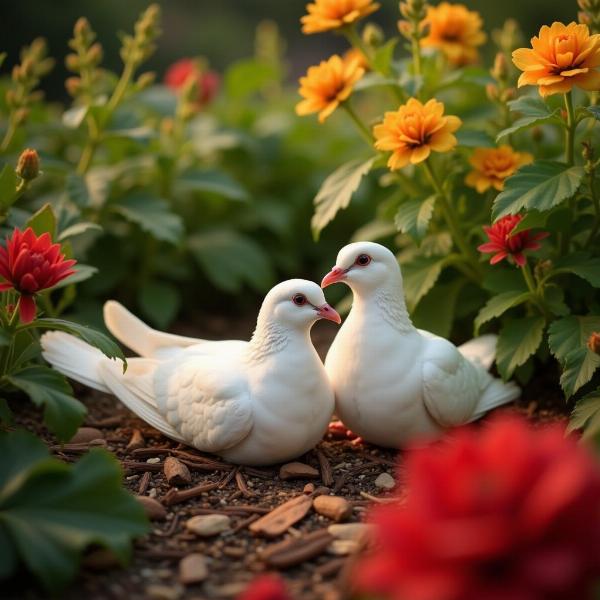Cooing, that soft, gentle sound, often associated with pigeons and doves, holds a special place in both the natural world and the Hindi language. Understanding its meaning in Hindi offers a glimpse into the rich tapestry of Indian culture, where the sounds of nature are often imbued with deeper symbolic meaning. But what exactly does “cooing” mean in Hindi, and how is it used in different contexts? This article will explore the various nuances of “cooing meaning in Hindi,” delving into its literal translations, cultural significance, and literary applications.
Unveiling the Hindi Translations of Cooing
The primary Hindi word for “cooing” is “गुटरगूं करना” (gutargoo karna). This verb perfectly captures the murmuring, gentle sound made by doves and pigeons. It’s often used to describe the affectionate communication between these birds, particularly during courtship. Another commonly used term is “कूं-कूं करना” (koon-koon karna), which is an onomatopoeic representation of the cooing sound itself. This term is more straightforward and directly mimics the sound the birds make. Depending on the specific context, other words like “फुसफुसाना” (phusphusana – to whisper) or “मधुर स्वर” (madhur swar – sweet voice) might also be used to describe the soft, melodious nature of cooing.
The Cultural Significance of Cooing in India
In India, pigeons and doves are often seen as symbols of peace, love, and purity. Their gentle cooing is considered auspicious and is often associated with positive energy. In many Hindu traditions, feeding pigeons is considered a pious act, a way to connect with nature and earn blessings. The cooing sound, therefore, becomes a reminder of this connection, a gentle soundtrack to a spiritual practice. Furthermore, in literature and poetry, the cooing of doves often symbolizes romantic love and longing. The soft, melodious sounds mirror the tender feelings of lovers, adding a layer of depth and emotional resonance to the narrative.
Cooing in Hindi Literature and Poetry
The evocative imagery of cooing doves frequently graces the pages of Hindi literature and poetry. Poets often use the cooing sound as a metaphor for the sweet nothings whispered between lovers, the yearning for connection, and the delicate dance of courtship. The cooing sound, with its inherent gentleness, also adds a touch of serenity and peace to the poetic landscape, creating a sense of tranquility and harmony.
 Doves cooing amidst lush greenery in an Indian garden
Doves cooing amidst lush greenery in an Indian garden
Cooing Beyond Birds: Exploring Metaphorical Usage
While primarily used to describe the sound made by birds, “cooing” can also be used metaphorically in Hindi to describe the soft, gentle sounds made by humans, especially babies. The term “गुटरगूं करना” (gutargoo karna) can describe the babbling of infants, evoking a sense of innocence and tenderness. Similarly, it can also refer to the hushed whispers of lovers, creating an intimate and romantic atmosphere.
What does the sound of cooing represent emotionally?
The sound of cooing often represents peace, tranquility, and love. In the context of birds, it signifies communication and bonding, particularly between mates. In a broader sense, cooing can evoke feelings of gentleness, comfort, and contentment.
How is cooing different from other bird sounds?
Cooing distinguishes itself from other bird sounds with its soft, low-pitched, and repetitive nature. Unlike the sharp chirps or calls of other birds, cooing has a mellow quality that is often associated with relaxation and intimacy.
Conclusion: The Multifaceted Meaning of Cooing in Hindi
From the gentle murmurs of doves to the babbling of infants, “cooing meaning in Hindi” encompasses a rich tapestry of meanings and cultural associations. Whether used literally or metaphorically, the word evokes a sense of gentleness, love, and connection with nature. Understanding its nuances allows us to appreciate the depth and beauty of the Hindi language and the rich cultural heritage it reflects. The cooing sound, a simple yet profound element of the natural world, continues to resonate within Indian culture and language, serving as a reminder of the beauty and interconnectedness of all living things.
FAQ:
- What is the most common Hindi word for “cooing”? The most common Hindi word for cooing is “गुटरगूं करना” (gutargoo karna).
- What does cooing symbolize in Indian culture? Cooing is often associated with peace, love, and purity in Indian culture.
- How is cooing used in Hindi literature? Cooing is often used as a metaphor for romantic love and longing in Hindi literature and poetry.
- Can “cooing” be used to describe human sounds in Hindi? Yes, it can be used to describe the soft sounds made by babies or lovers.
- What is the difference between “गुटरगूं करना” and “कूं-कूं करना”? While both refer to cooing, “कूं-कूं करना” is onomatopoeic, mimicking the sound itself, while “गुटरगूं करना” is a more general verb.
- Why is feeding pigeons considered a pious act in India? It’s seen as a way to connect with nature and earn blessings.
- Does the meaning of “cooing” change depending on the context? Yes, the specific meaning can vary depending on whether it’s used literally or metaphorically.
Meaning-Hindi.in is your one-stop solution for all your Hindi translation needs. We offer a comprehensive suite of translation services, from business and legal documents to website localization and educational materials. Our expert team ensures accurate and culturally sensitive translations, bridging the language gap and fostering effective communication. Contact us today for high-quality, reliable Hindi translation services. Email: [email protected], Phone: +91 11-4502-7584. Meaning-Hindi.in is committed to providing top-notch translation solutions tailored to your specific needs.